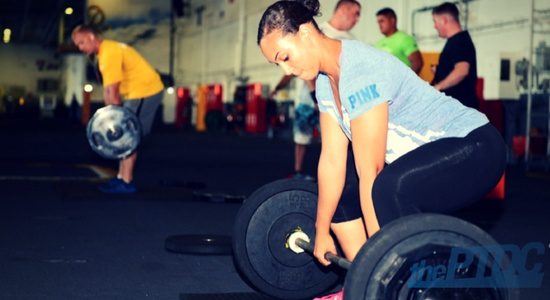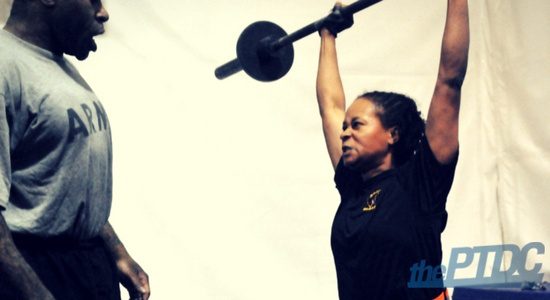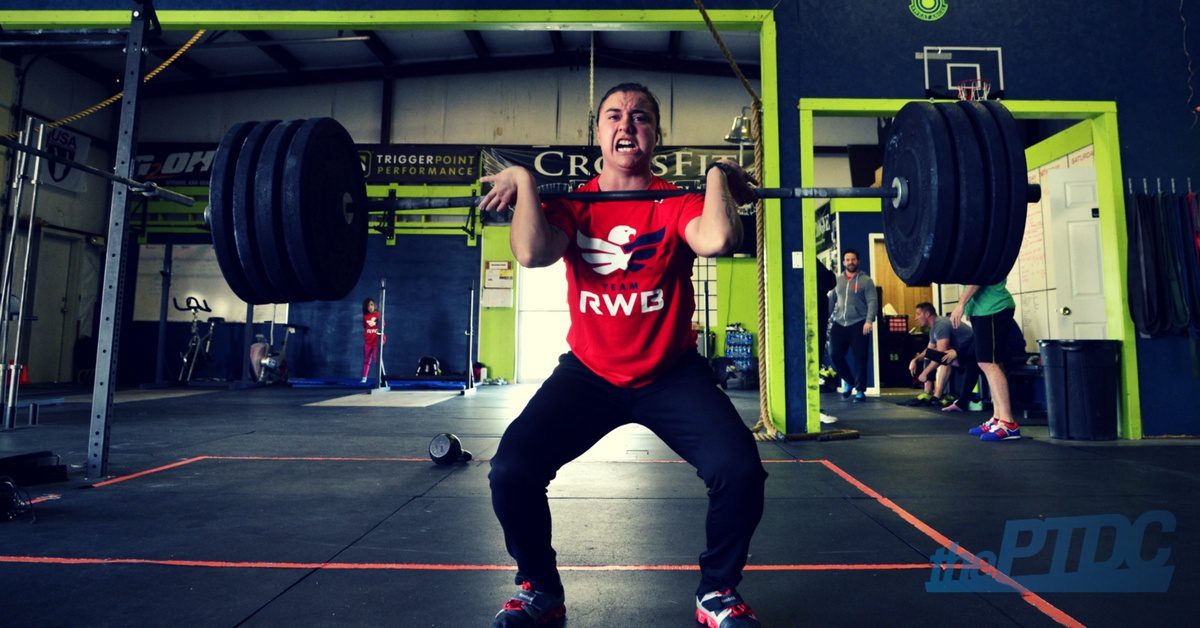Once upon a time, in a universe not so long ago or far away, it was rare to see cleans, clean and jerks, and snatches being performed at your average gym. But with the rise of CrossFit and sports performance-focused training, more people are now doing these Olympic lifts.
Or maybe I should say trying to do these Olympic lifts.
Perhaps your own personal training clients have started asking you about them and want to learn some Olympic lifting. While it's good that your client is showing interest in these powerful movements, this begs the question:
Are cleans, snatches, and clean and jerks really a good idea for your clients, especially if they don't have aspirations to compete and just want to be fit and healthy?

This isn't an easy question to answer. As with most exercise prescriptions, you need to:
- First, analyze your client's current program and goals.
- Second, do a cost/benefit analysis of Olympic lifts versus classic lifts.
- Third, consider whether adding Olympic lifts will help your client.
- Fourth, do some gut-wrenching soul-searching on whether you really have the expertise to properly coach the highly technical Olympic lifts.
We'll address these in the coming sections to help you decide whether your client is best suited for Olympic lifting.
Do Olympic lifts fit your clients needs?
The benefits of Olympic lifting on athletic performance and improved nervous system will benefit your client, plain and simple.
Have you heard of dynamic correspondence? It is a concept that was coined by Yuri Verkhoshansky. It emphasizes picking exercises based on how well they correlate to a given sport.
In the case of Olympic lifts (or "Oly lifts"), these explosive movements more closely mimic the dynamic effort of athletic movement, the direction of movement, and the rates of force development than classic lifts do. Oly lifts improve the lifter's sports performance because they require a lifter to rapidly extend through the hips, knees, and ankles--termed triple extension. It is similar to the biomechanical demands of sprinting and jumping. By improving one's ability to do Oly lifts, power generation in those athletic movements also improve.
Oly lifting also improves intramuscular and intermuscular coordination. Intramuscular coordination is the coordinated firing of motor units within a single movement. The better your intramuscular coordination, the smoother and more explosive your movement. It is driven by three components: rate coding, recruitment, and synchronization. In other words, how fast your body sends and receives signals via your nervous system; recruiting more motor units; and recruiting multiple muscle units simultaneously to perform an action, respectively.

Intermuscular coordination, on the other hand, improves nervous system function within a specific movement pattern. For example, the triple extension from Olympic movements is a mechanically similar movement pattern as sprinting, and thus sprinting performance can be improved. It's the same reason a squat improves someone's ability to get up from a chair.
Together improved intermuscular and intramuscular coordination teach your client's nervous system to recruit fewer motor units for the same relative intensity. This means that for your clients who are weekend warriors or competitive athletes, these two benefits--better coordination and nervous system function--just make them perform better in the following ways:
Your clients will generate more power: Power, the blend of speed and strength, is one of the most important components of performance. Higher power output improves nervous system function and helps you generate strength, faster. It teaches your nervous system to recruit more muscle fibers. The result? You produce movement with less stress on the system.
Your clients will get stronger: Explosive hip and knee extension are the primary drivers of performance in the Olympic lifts. Not coincidentally, the same mechanics also help the squat. Since the movement patterns are relatively similar, explosive Olympic lifts improve muscle fiber intermuscular and intramuscular coordination to improve lifts like deadlifts and squats.
Your clients will build more muscle: Normally, pure strength training is important for building muscle, but people can't train heavy all of the time. Eventually, something will give, especially with most busy and stressed personal training clients.
With explosive Oly lifting, your client can fire up the nervous system and recruit more muscle fibers without the same stress as that from consistent heavy lifting with the classic compound lifts. Then, by turning on more muscle fibers from heavy or explosive lifting, the more muscle units you recruit and the greater the training response to stimulate muscle growth.
Comparing Olympic lifts versus "classic" lifts
After all of that, you must be thinking about this mega-important issue: Can traditional exercises like squats and deadlifts offer the same benefits as Olympic lifts?
For the most part, yes.
The real driver of Olympic lifts and power is maximum explosive intent. That is, your client (or you) focus on generating strength as quickly as possible from doing exercises, such as a squat jump, back squat, or clean.
Certainly, there are many instances during which compound lifts like the squat and deadlift are superior to the Olympic movements. For one thing, they are less complex, and thus, less likely to result in technical breakdown and injury. Not to mention squats and deadlifts are foundational movements that people use every day, whether they're trying to get strong or not.
The other thing is that everything in training has a cost-to-benefit ratio. For example, is it worth your time--and your clients' time and money--to tackle the Olympic lifts, when they can get many of the same benefits from less demanding means?

Only you can answer that question.
Beyond that, you need to consider the elephant in the room: Do you really have the ability to teach the Olympic lifts?
Here's my position. It may be controversial and provoke some push back, but it's what I believe from deep in my heart: If you can't master an exercise and teach it, you have no business testing it with your clients. Ever. Otherwise, consider it gross negligence, bad coaching, and an injury just waiting to happen.
Four questions to ask before adding the Olympic lifts to a program:
1. Do you know the proper technique and programming for the Oly lifts?
Yes? Go ahead. No? Attend a seminar such as the USAW Level I and prepare to practice for months afterwards. The courses are an excellent, weekend long course and cost between $450 and $700 dollars, depending on location.
2. Does your client need Olympic lifts to compete?
If they're entering a weightlifting meet or CrossFit competition, the answer is obviously yes. If your client needs to do the lifts for a sport or sports team program, learn the Oly Lifts and teach them.
But, but, but...
Are your clients just interested in building muscle, improving health, and feeling better? Use your best professional judgement. But consider the strong possibility that Olympic lifts may not be right in all circumstances.
3. Does your client have a solid base of strength?
The main benefit of Olympic lifts is power, which is the sum of strength and speed. But without a base of strength, you won't build power. Some coaches and fitness enthusiasts folks may disagree, but my position is most folks should train with basic compound movements like the squat and deadlift for 6-12 months or more before jumping into the Olympic lifts.
4. Are Oly lifts worth your and your client's time?
Olympic lifts are complex, often taking months of focused practice for clients to become proficient. Expertise takes years. Surprisingly, one population that could greatly benefit from Olympic lifting is older people. In 2002, the American Geriatrics Society found that high-velocity resistance training increases skeletal muscle peak power in older women, which lends credence to the idea of developing power for functional capacity in older clients.

These benefits of strength and power can improve quality of life and performance in aging clients. Doing an explosive Oly lift teaches them to catch themselves before they fall, which requires a quick step forward.
Indeed, squats and deadlifts are options as well, but now you can also decide whether sub-maximal Olympic lifts and their variations, like high pulls, can be appropriate for your client. Either way, the final decision requires your best professional judgement based on your client's training history and your own expertise.
On the coach's end, a weekend seminar with the USAQ is a great start, but it isn't enough to learn and master coaching the Olympic lifts. Coaches themselves need months of practice both learning and coaching Olympic lifts. Stay up-to-date and continue learning from coaches like Wil Fleming and sites like JTSStrength.com and the USAW.
If you deem the snatch and clean essential to your client's success, learn, prepare, and spend plenty of time teaching.
If you don't think months of practice and teaching Olympic lifts is worth the time, look for other means of power development (more on that ahead).
What if full Olympic lifts aren't an option?
If you're at a gym without necessary equipment or--gulp--has rules that prohibit Olympic lifts, you still have many options. Further, if a client is ready for full cleans or snatches, start off with partial movements to groove technique and practice. No matter your direction, the key is explosive intent and generating strength fast.
Here are my favorite non-Olympic exercises to do so:
Partial Olympic lifts:
These variations build many of the same explosive qualities of the full lifts without the same technical demands.
High pull: A power clean without the catch. This works well to reduce stress on the wrists and elbows while training explosive hip extension.
Hackey pull: A basic regression that focuses on explosive hip extension. Plus, booty gains.
Dumbbell Olympic lifts have a shorter learning curve and work well in travel and hotel settings.
Dumbbell cleans
Dumbbell clean, squat, and press
Dumbbell snatch
Box Jumps
Squat jumps
Broad jumps
Medicine ball back toss
Medicine ball slam
If you use lighter, compound lifts, use squats, deadlifts, bench presses, and other compound lifts with lighter weights and a focus on accelerating through the concentric with maximum speed.
The takeaway
As coaches, we all have biases towards lifts that have helped us and our clients succeed in the past.
Olympic lifts are great for athletes and those interested in performance, but they do carry risks. Weigh the risks against the benefits. In this case, you are considering time, energy, and potential injury versus acquisition of explosive movement and power,
And if you decide the cost and benefits don't check out for your client, remember, there are many ways to develop explosive movement and power that do not require the Olympic lifts.
Other coaches found these articles helpful:
- The Real Reason Why People Must Squat Differently by Ryan DeBell
- 5 Daily Habits That Will Make You a Better Personal Trainer by Eric Bach
- Troubleshooting the Deadlift by Justin Kompf
Photo Credit: Featured Image Wikimedia, Image 1 by Pixabay, Image 2 by Pixabay, Image 3 by Wikimedia, Image 4 Wikimedia
References
1.Siff, M., and Y. Verkhoshansky. Supertraining. (6th ed) Rome: Verkhoshansky, 2009.
2.Suzuki T, Bean JF, Fielding RA. Muscle power of the ankle flexors predicts functional performance in community dwelling older women. J Am Geriatr Soc 2001;49:1161-1167.
3.Centers for Disease Control and Prevention, National Center for Injury Prevention and Control. Web-based Injury Statistics Query and Reporting System (WISQARS) . Accessed August 15, 2013.









